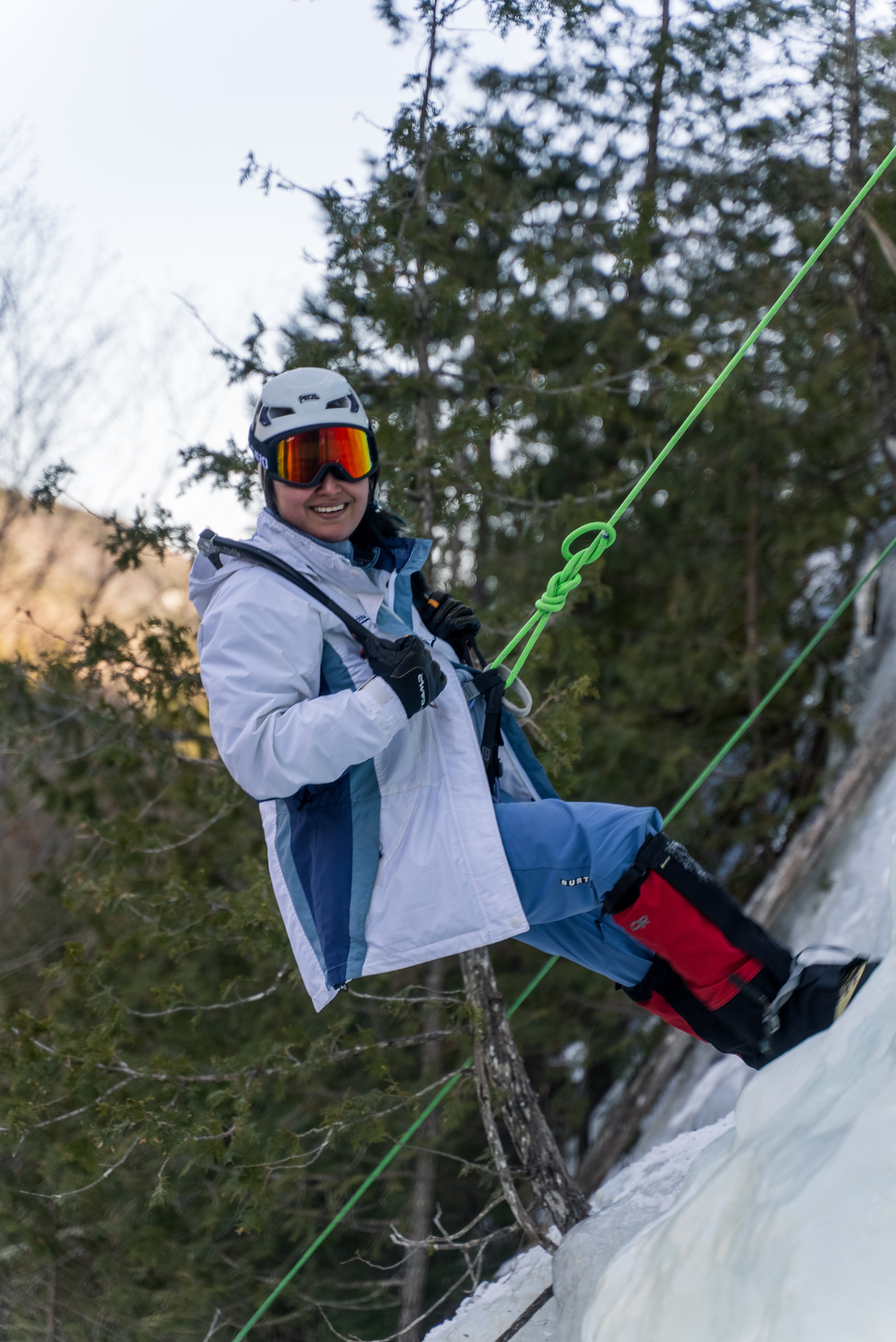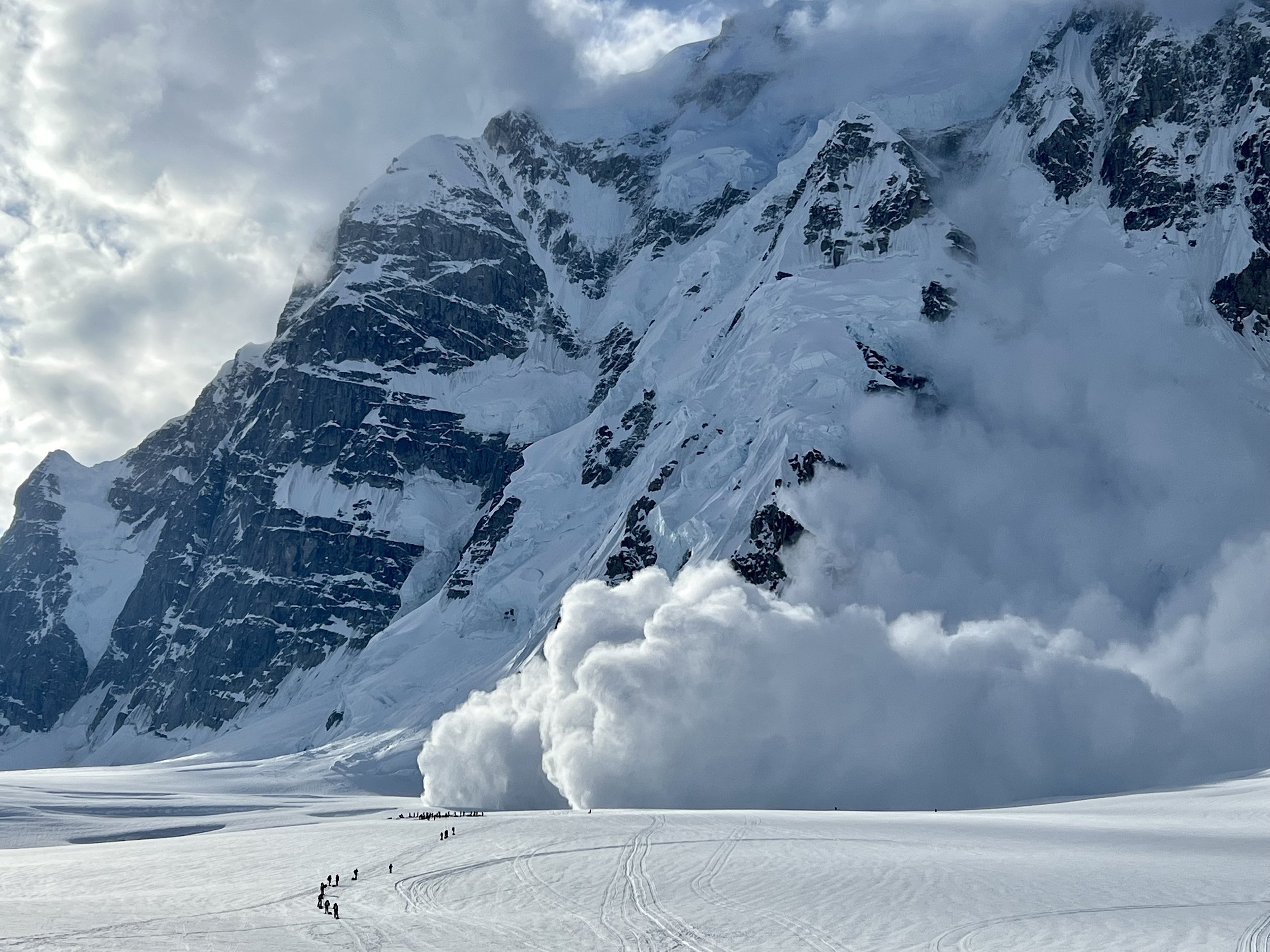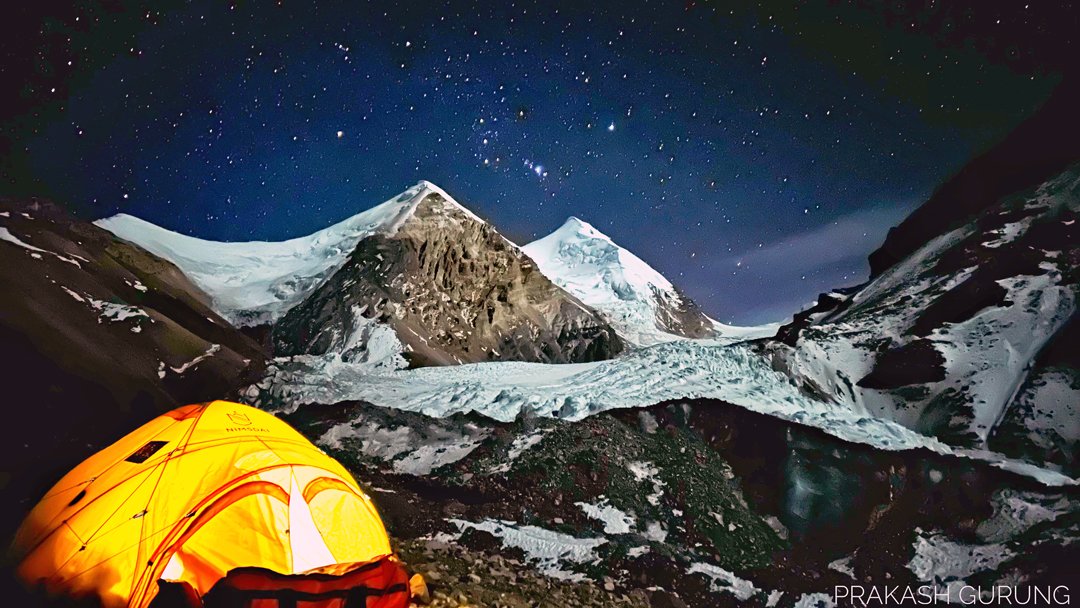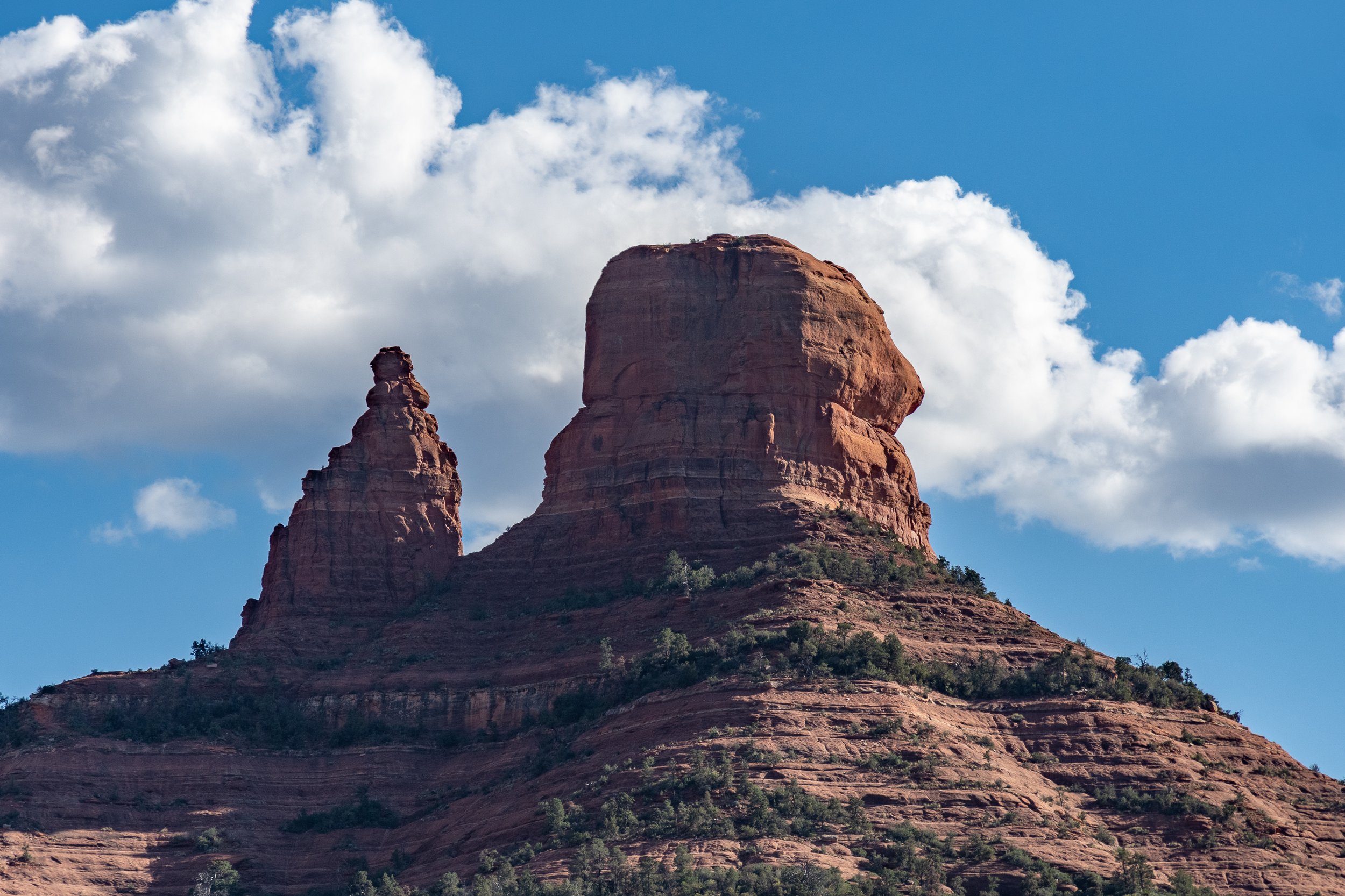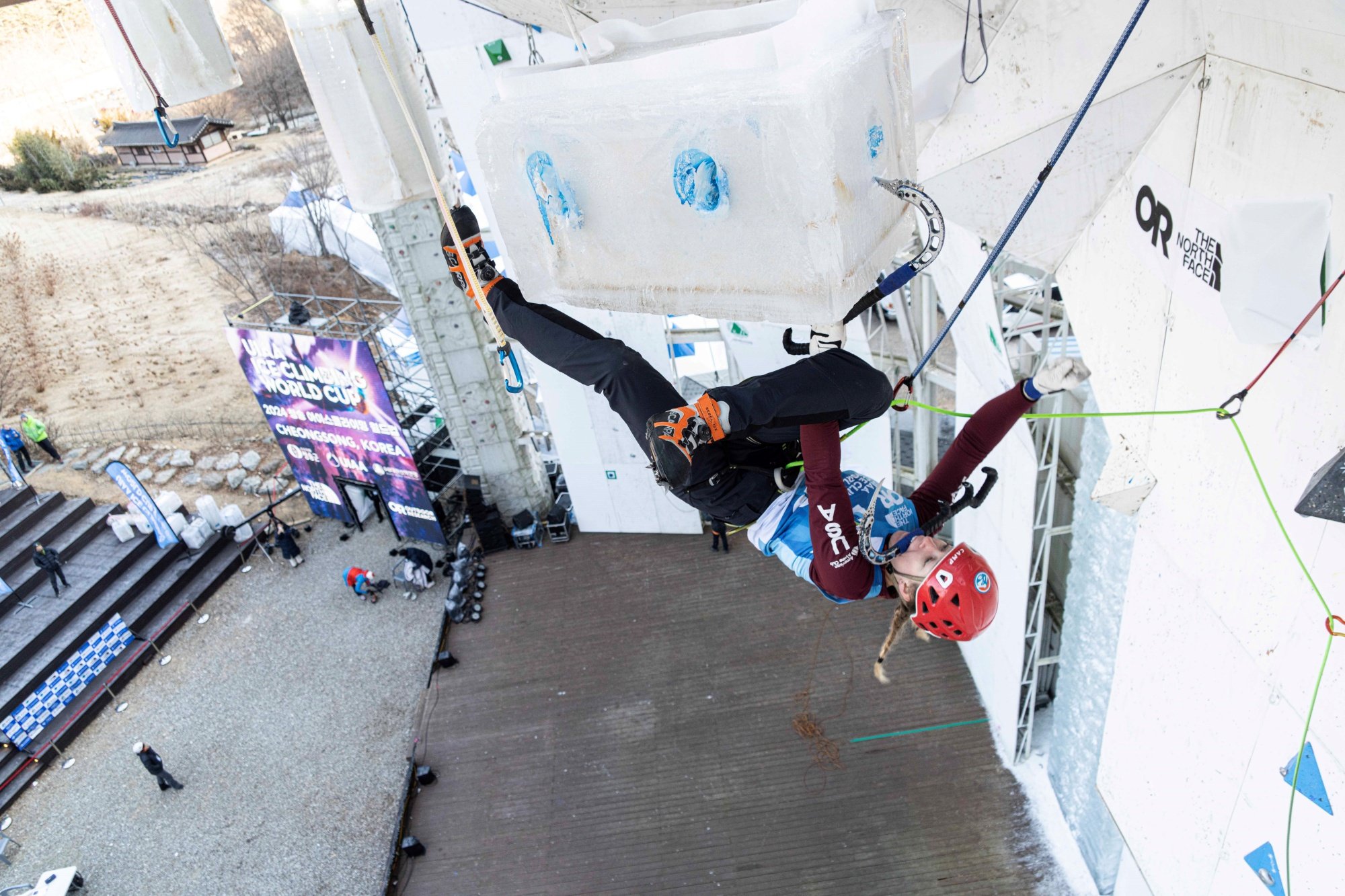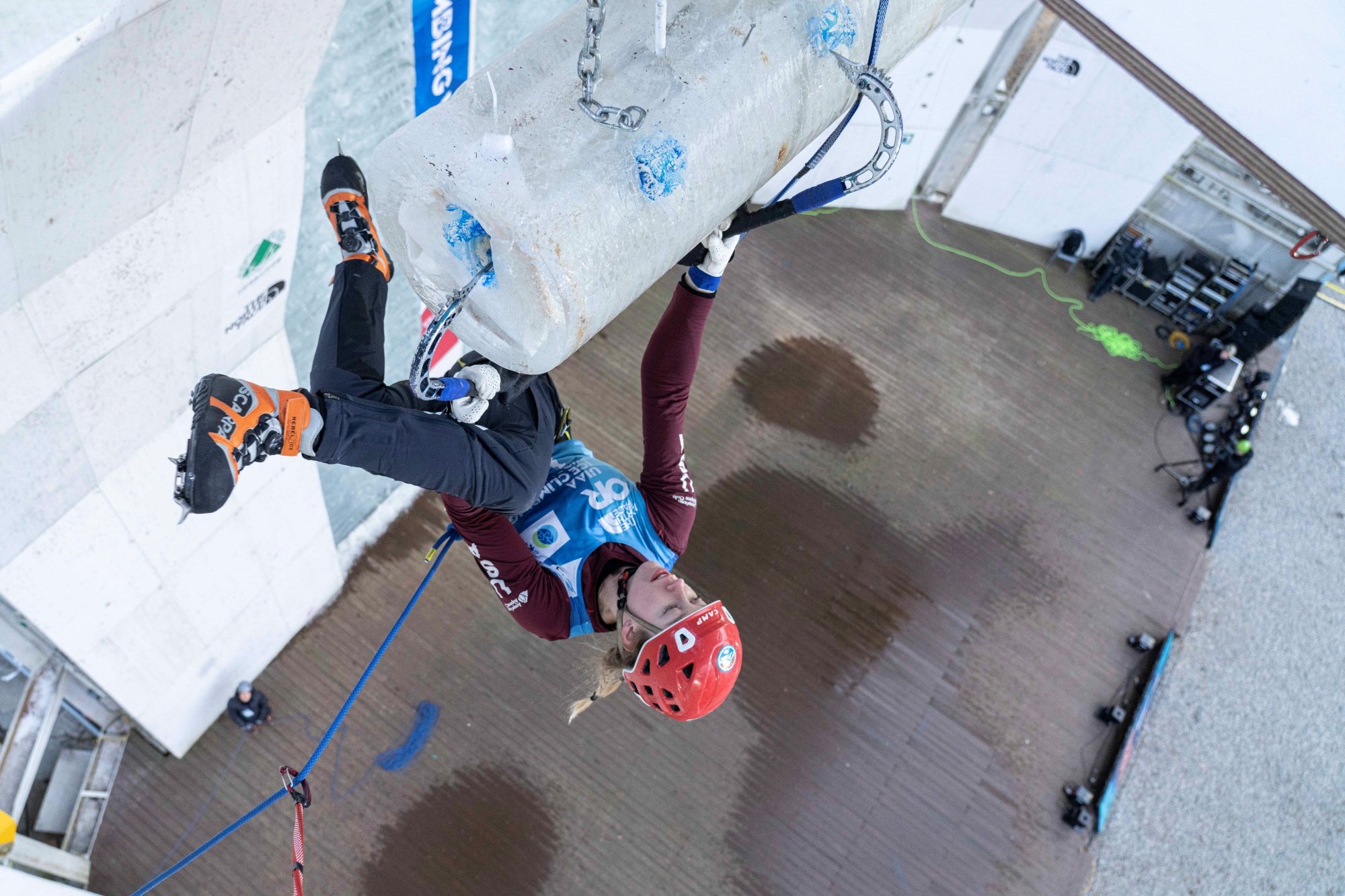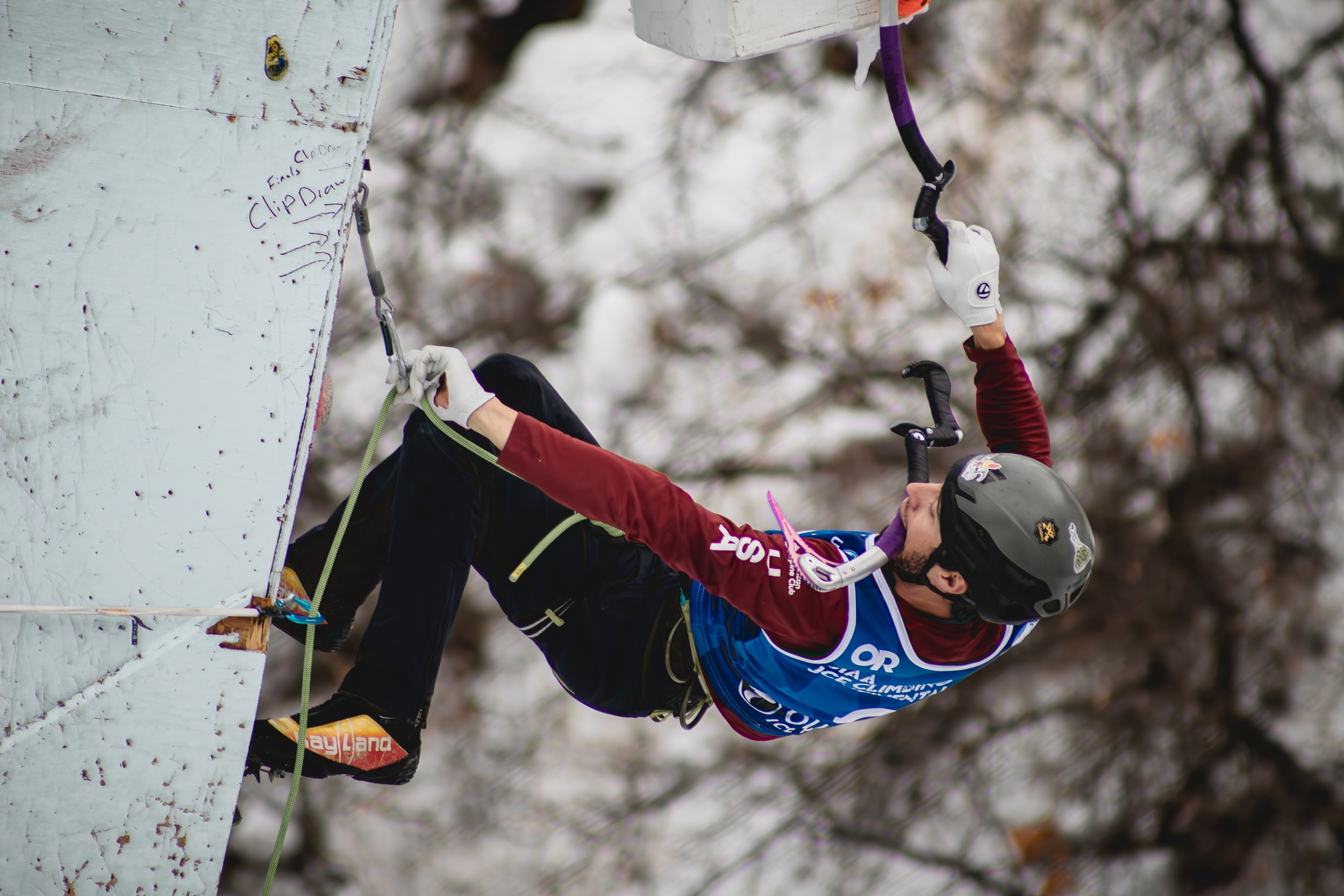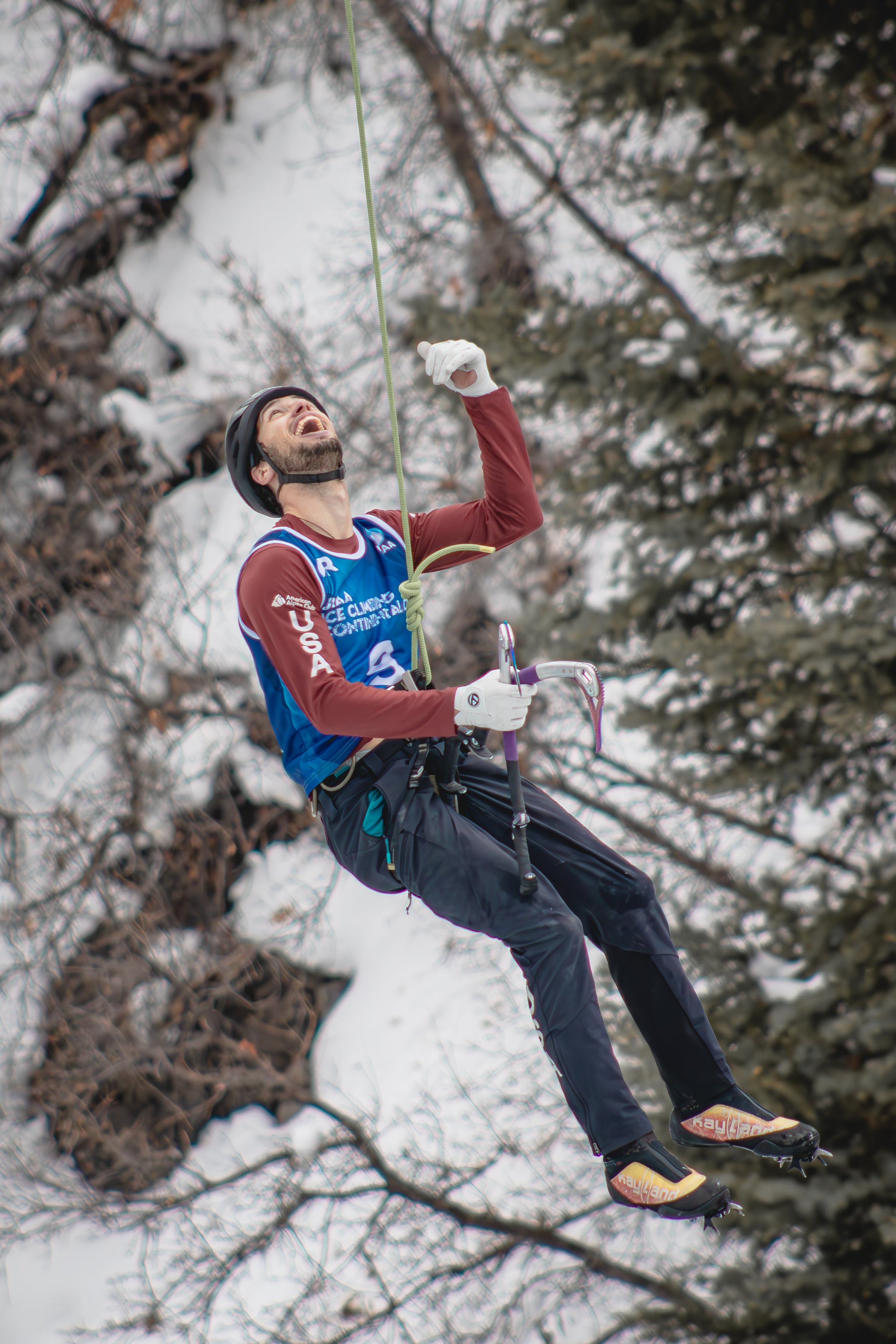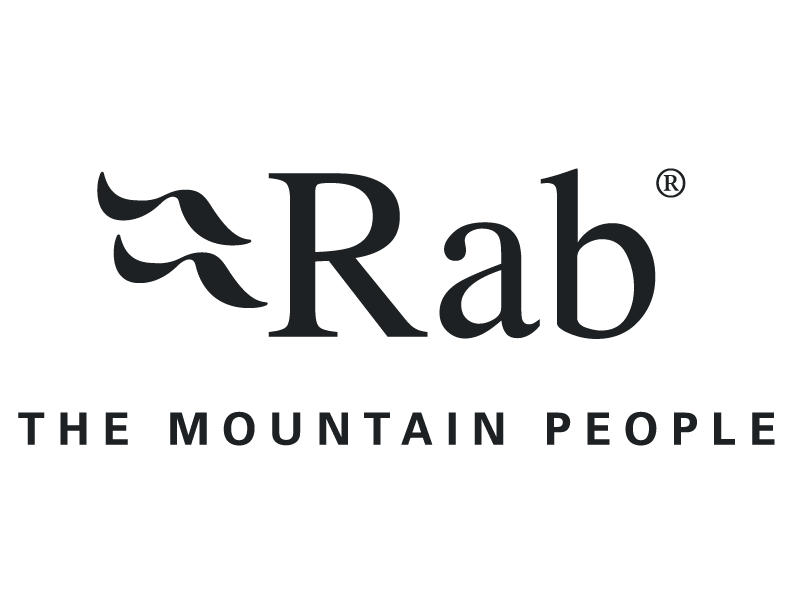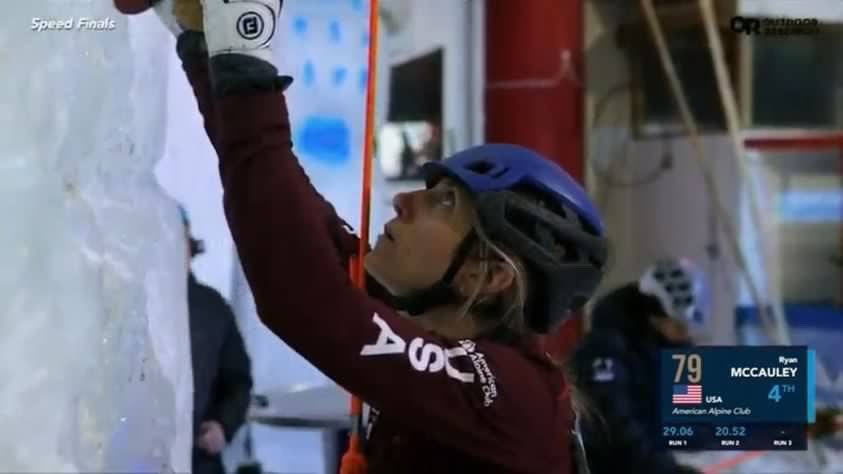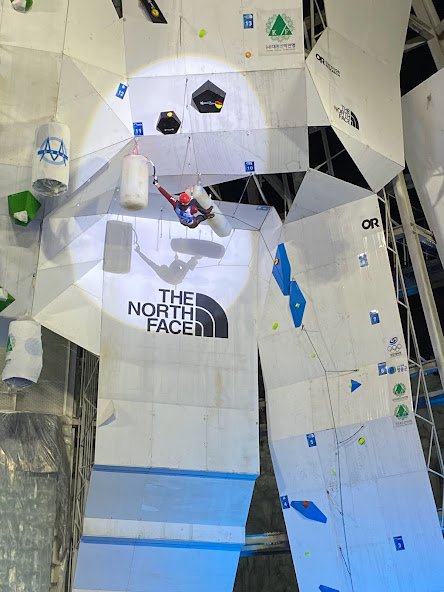Keenan Griscom giving it his all during the 2023/2024 competition season. Photo courtesy of the UIAA
Every year, ice climbers flock to the Ouray Ice Festival to test their skills on the human made ice flows in the park. A select few test their skills on the ice climbing competition wall. Routes are created that include ice, rock, and plywood in the Scottish Gullies section of the ice park.
The American Alpine Club sat down with USA ice climbing competitor Keenan Griscom. Griscom was rocking a North Face leopard-print 1996 retro Nuptse puffer and Y2K gray wrap-around sunglasses, as chill as the ice around us. We chatted about growing up competing in ice climbing competitions, his new link up Tommy's X (5.14b) in Clear Creek Canyon's Nomad’s Cave, and his experimental competition headspace. The experiment succeeded clearly, since Griscom took home the gold in the Ouray men's lead finals the next day.
AAC: You were the youngest American to win the Ouray Elite Mixed Climbing Competition at age 16. When did you start climbing? How did you get into competitive ice climbing?
Keenan Griscom: My dad actually started me ice climbing when I was four or five here in Ouray. So I've had tools for a long time. And then through Marcus Garcia, [I] found the competition scene and got hooked. I was doing rock comps, and the community in the ice climbing comps was just, so, so good and supportive and friendly, so, as someone who's already into competing, starting the ice comps is just like, oh, this is it. This is a cool spot to be in.
AAC: What was it like competing at such a young age?
KG: I don't know, I've been competing since I was nine. It was somewhat second nature. I've always wanted to give it [my] all in the comps. And Ouray was really special because when I started, there weren't any age categories. It was just the open format, and anyone could sign up. So if you were in, you're competing with everyone. My first two seasons, I didn't place particularly well. But it was so cool to be competing with people like Will Gadd and Ryan Vachon and all these epic mixed-climbers and alpinists who I looked up to.
AAC: What drew you to continue doing competition ice climbing while you fell away from competition bouldering and rock climbing?
KG: I stopped competing in rock comps mainly because the scene isn't as welcoming. There's a lot more toxic competitive nature there, and a lot of people get really worked up and will take other people down to get a better result. There's not really any of that in the ice climbing crew. Ice climbing comps are really fun. I'm going to stick with that. But I've been rock climbing outside nonstop.
AAC: On that note, I noticed you put up an alternative finish to Tommy's Hard Route (5.13d)—Tommy's X (5.14b). What is the relationship between route development and ice climbing? How do those two things relate, if at all for you?
KG: They don't relate a ton since I haven't really done much development for ice or mixed. I've gotten a lot of help from mentors like Marcus, who I met through ice climbing, to teach me development ethics. That route, specifically, it's in a cave near my house, and there's a lot of link ups. I didn't put in any new bolts [for Tommy's X] it was just a new line that hadn't been done yet.
AAC: And what inspired you to do that?
KG: Tommy's Hard Route (5.13d) is an old school natural line in a cave that's almost all manufactured. There is this really, really big dead point crux that I always thought was super, super interesting. Then it's over. You do this really gnarly dead point, and it's jugs to the chains. Which is nice, but more sustained climbing is more my style. There's this other route called Predator X (5.13a/b) that comes in from the left and finishes basically directly above that dead point. And one day, I was wondering if I could link those up, and then it'd be like a perfectly straight line of bolts through the wall. Yeah, it ended up being a really interesting crux sequence after the initial crux.
AAC: That's awesome. You also boulder, can you tell me a little bit more about that?
KG: Yeah, I grew up almost exclusively sport climbing, and then started to do a little bit of bouldering through friends and kind of got hooked on it, because it’s a little bit easier. You can go out and solo sesh a lot of stuff in Clear Creek Canyon near the crib. I took that and ran with it. I've been doing more bouldering than sport lately, and that's currently what I'm probably most excited about, pushing bouldering grades.
AAC: Do you have a preference between sport climbing, bouldering, ice climbing, ice climbing competition, and mixed climbing?
Keenan Griscom is all about staying chill, captured during the 2023/2024 competition season.
KG: Really hard to say. I might put bouldering at the top, but then it's a massive tie for second. Ice climbing comps are unbeatable. There's no other scene that's as fun and welcoming, and the movement is so dynamic. You just don't get the same movement on rock. It's a really fun change of pace. With actual ice and mixed I'd really like to get into doing some more big things and exploratory multi-pitch in [Rocky Mountain National Park]. But I've definitely been more focused on competition and rock climbing lately.
AAC: What does training look like for you?
KG: It depends. This year has been more casual—been working on a lot of power, strength, and technique. Last season was a pretty full-on training block. I basically trained from August through December, like super structured for the World Cup tour, and it ended up panning out really well.
AAC: It definitely did, you received the overall World Cup lead medal in silver, last year. What about competition ice climbing sparks inspiration or joy for you?
KG: Initially, it's like basically everything your parents tell you not to do. You get to jump around with blades on your feet and in your hands and take massive falls in the air. Honestly, on the World Cup scene, it's all a massive party. Everyone's a big family. I find the movement really fun. It's really physical. So you get to actively try hard while you're doing it, which is a good feeling. Honestly, it's the community, like the scene is so fun. That's a large part of why I'm here.
AAC: Who do you think you are as an ice climbing competitor?
KG: I'd like to say Keenan is just a climber who wants to do it all. In ice climbing comps, I'd like to be seen as someone who's really focused on doing as well as they can. But I've done some coaching in Boulder at the Ice Coop, and for me to, like, not feel the stress of the competition, I tend to try and help everyone; making sure everyone else is doing good helps me a lot with not worrying about how it's gonna go. So I guess I would like to be seen as someone who's a wealth of knowledge to come and get help from. But at the same time, I'll put my headphones in and lock in for the warm-ups.
AAC: Who are you outside of climbing?
KG: Outside of climbing, I'm trying to be an artist. I'm wrapping up my Arts Associate right now. I'm a little unsure of what I'm doing afterwards, but I'll figure it out.
AAC: What mediums do you work in?
KG: Fashion and then dry mediums, so, charcoal and graphite.
AAC: What do you hope to get out of this 2025 season?
KG: I'm really excited to go into it with a casual mental space. I'm trying to just put it all on the line during the competitions. I haven't done as much training and prep for this season. I'm trying to play around with different approaches to the competition headspace. Instead of treating it as a competition, I want to treat it as redpointing a project. The goal is not to get a certain placement, or even do well in the comp. The goal is to top the routes. At a world cup level that almost always means winning. It's not like I want to win to top the route, I just want to top. Topping is the main objective.
AAC: What has been the most pivotal moment in your climbing career?
KG: In competition climbing, it was definitely my last season as a U16. I won that year's Youth World Cup. The whole prep I was focused on winning, and when I won, it wasn’t very fulfilling. I felt pretty hollow. That drastically changed how I approached my whole preparation and training. I think that was a massively positive moment.
[For] rock climbing it's really hard to say. I think potentially [when I stopped] competition rock climbing, because I grew up doing camping trips to Indian Creek and Vedauwoo and following leads all the time. And taking a step away from the competition rock was really nice and refreshing to go back to the routes and try really hard on rock without any external things happening.
AAC: If you could be any climb, what would it be and why?
KG: I have two lines in mind. Biographie (9a+/515+) in Céüse, France, because it is the most beautifully perfect chunk of rock I have ever seen. It just looks so incredible—proper dream line. Or Off the Wagon (V14), that V14 in Switzerland. The beta on that thing is the definition of swagger. It's so cool.
AAC: Could you elaborate on that, and leave us with some climbing beta humming around in our heads?
KG: Yeah, the history of that boulder is pretty sweet. Dave Graham and Chris Sharma tried it forever ago, and it's this massive right hand dead point for this first move and then you do a campus row sequence. And that's it. It's a two move V14. It's smash, hold, campus, done. It's in this beautiful little meadow valley in Switzerland, and you start on a wagon. It's a really cool chunk of rock. It's like a perfectly flat 45 degree panel.
Just one podium among many. Keenan Griscom celebrating his bronze medal in the 2024 Champagny Continental Open. Photo courtesy of the UIAA
For the Ouray Competition men's results, click here, and for the women's results, click here. The Ice Climbing competition scene returns to Colorado for the World Cup in Longmont on Feb. 22-23. Watch Team USA compete this February, or learn more about getting involved here.
Want more ice climbing content? Check out A Little Extra Spice: Stories from the World of Competition Ice Climbing









